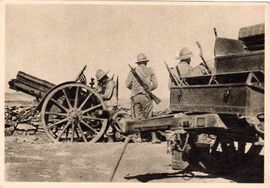Contents
Background Edit
Edit
The war goes back to the legacy of the Third Global War when the Kingdom of Italy was created and Italy became a powerful rival of the Byzantine Empire in the Mediterranean. They had built up a colonial empire by taking Libya in the Treaty of Rome, and establishing colonies in Eritrea, Somalia, and Tunisia. They had an army based on conscripition, as was common in Europe at the time, and it numbered at around 1,000,000 and a powerful navy of 4 battleships at the head of its fleet. The Byzantines, after the Reforms of 1898, had an army of 3,000,000 men, a navy of 8 battleshipsat its head, and their own air force, with 40 aircraft, all aerial scouts. The Italians had some aerial scout units, but they weren't their own military force.
Another field that had made major development was fuel, as petroleum, mainly crude oil, had become the stuff of billionaires and tycoons, and had already revolutionized the western world, as did the automobiles which depended on thems. Both Italian and Byzantine territories had proved priceless in their production, and both countries began developing major petroleum and automobile industries. But one thing that the Byzantines had thought of was how could automobiles be used in warfare.
One prize that had tempted both Italy and the Byzantines was Ethiopia. The Ethiopian Empire had existed for centuries, and had always been to powerful and modern to conquer. But modern advances had not yet arrived, mainly machine guns, airplanes, and steel warships, putting any invading nation at a strong advantage. The Byzantines saw their proximity to the empire as a possible advantage, and knew Ethiopia would be easy to conquer. Because Ethiopia had little in ways of petroleum, the only main reason for invading was to put a pain in Italy's side. But when Ethiopia and Italy signed the 1899 Treaty of Addis Adaba, which effectively made Ethiopia an Italian puppet state, so taking what was effectively Italian territory would be payback for Italy taking Libya.
All of these culminated in the declaration of war the Byzantine Empire declared on Ethiopia in February 1905. And just days after the declaration of war occured, the Kingom of Italy declared war on the Byzantine Empire, as per the Treaty of Addis Adaba.
Northern Theatre Edit
Edit
The Byzantine IV African Corps, numbering at around 50,000, became the first unit to enter Ethiopia in May 1905. Aksum was the first major center of Ethiopian resistance where an Ethiopian force of 22,000 engaged the Byzantines on May 22, 1905. The Ethiopians had divided up into three waves, but their inferior tactics only let them all be slaughtered when Byzantine machine guns opened up on their advancing lines. Mek'ele however, provided the first resistance from both Ethiopians and Italians, as 40,000 Ethiopians and 30,000 Italians put the IV African Corps to the test. However, the IV Corps was able to hold a battle in the city until on June 15, when the remainder of the II African Field Army arrived, bringing their force up to 200,000, bringing enough force to push the enemy out of the city.
The Byzantine II African Field Army pushed deep into Ethiopia until they arrived in Weldiya, where the surrounding area had been turned into a major defensive position, complete with artillery and machine gun nests. While Byzantine forces advanced on the town, Italian aircraft radioed in their position, until the Byzantine V Aerial Squadron arrived, as some of the first armed aerial scouts in history, equipped with two-seats, one for the pilot and oen for a rear machine-gunner. The new model was called the Pegasus Md.7 and within minutes, the Italian scouts had all been shot down by superior fighters. The Byzantines now marched against enemy fire to take out their artillery, eventually they moved their own artillery into play and tore up the enemy's machine guns nests.
The final major engagement from the north was the Battle of Dessie, where a group of Italians and Ethiopians,
Mark I Byzantine tank at Dessie
Now that the Byzantines held Dessie, they employed their ultimate weapon against the Ethiopian's capital Addis Adaba, the bomber. 12 triple-decker bombers took off from captured air fields near Dessie, and dropped 200 bombs on the city, all incindiaries, causing Addis Adaba to catch fire, and resulting in the heavily-wooden suburbs almost compltely burning down. At that point, the Byzantine II African Field Army attacked from the north, while the Byzantine I African Field Army attacked from the south.
Southern Theatre Edit
Edit
The Byzantines marched their I African Field Army from their colony in east Africa to invade southern Ethiopia in 1805. And in October of 1805, they arrived in southern Ethiopia and attacked the towns of Bako, Dila, Yirga Ch'efe, and Kibre Mengist all simultaneously as to create confusion and to spread out the Ethiopian ranks. The towns each fell the same day they were attacked, and gave the Ethiopians a serious series of defeats that caused a general retreat to be called just two days later.
However, upon arriving at Tarch'a Sodo, Awasa, and Goba, they found town well defended by both Ethiopians and Italians. Each of the towns suffered heavy artillery bombardment, and eventually the casualties were too much for the defenders to bear, but as the Byzantines marched into Ethiopia, they were confronted with enemy querillas. Multiple areas around captured towns became centers for resistance by civilians, but as they were simple querillas, they were easily dislodged with machine guns and gernades. Though the guerrillas had stalled their advance for about a week-and-a-half, allowing them to retreat back north to their defenses in the north.
Nazret became the only major point of defense against the Byzantines that the Ethiopians had left before Addis Adaba. Defended by 80,000 soldiers, the city held out against attack for two weeks until three tanks came into their ranks and the defenders eastern defences fell to a light artillery barrage. Soon Byzantine infantry broke into the city and captured it within just eight hours of the breakthrough, opening the way for the Battle of Addis Adaba.
The Battle of Addis Adaba began when 4000 Byzantine troops surged through the defenses of the Imperial Highway to Addis Adaba from the south. Now as reinforcements arrived for the Byzantines, their numbers in the city swelled to 20,000. But they found a city in ruin, destroyed by bombers and with most buildings pounded down from artillery. When the 15 tanks the Byzantines employed also enterred the city, a race began for the National Palace at the city's center between the I and II African Field Armies. However, the main point of resistance became the city's eastern portion, where the I African Field Army was forced to send its tanks, giving the II Army the National Palace. Addis Adaba finally fell on May 14, 1906, ending the Ethiopian Empire and the Byzantine-Abyssinian War.
Aftermath Edit
Edit
The war ended with the Byzantine Empire annexing Ethiopia, giving them almost complete control of east Africa. But the tensions from the war would eventually lead to a new world war to be fought on an all new level in 1914. Meanwhile, the Ethiopian Emperor Menelik II and the Ethiopian royal family were given refuge in Italy, while the other parts of the government ultimately assimilated into the new Byzantine province, Abyssinia.


Δεν υπάρχουν σχόλια:
Δημοσίευση σχολίου